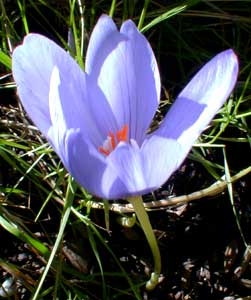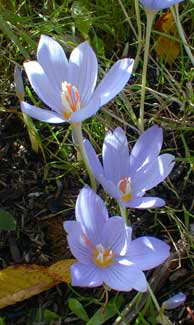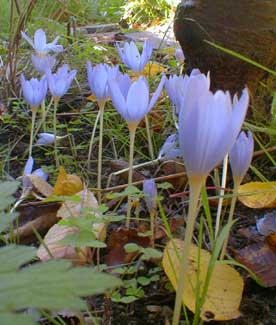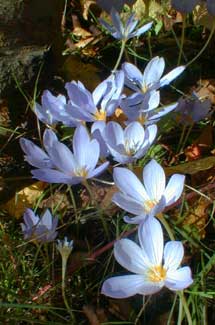 Balkans Autumn Crocus
Balkans Autumn Crocus
"Crocus blooming neath my feet,
Most sweet!"
-St. Therese of Lisieux
1873-1897
1873-1897
Crocus pulchellus is a vigorous autumn crocus which naturalizes easily, producing numerous bulblets all around the parent corm to increase its numbers with surprising speed year by year.
 It likes best full sun, but will tolerate light shade. The first three photos are from October 2003; the fourth from mid-October 2004; the fifth photo from late October 2005.
It likes best full sun, but will tolerate light shade. The first three photos are from October 2003; the fourth from mid-October 2004; the fifth photo from late October 2005.We planted about thirty bulbs at the base of a cherry tree that has dropped in the vicinity of half of its leaves by the time this crocus starts blooming, which lets in sufficient bright light that the blooms do open fully in the afternoon. They would open sooner in the day if they got direct sunlight earlier, but the house shadows them in the morning.
On overcast days they fall on their sides & look most untidy, but stand up straight & sturdy when the sun hits them, hence a lot stronger-stemmed than most other autumn crocuses.
Native of Macedonia, Serbia, southern Bulgaria & northern Greece, it is commonest in Northwest Turkey & the Balkans.
 It grows four to six inches tall. Subtle, pale lilac flowers with purple veins occur mainly in October, often still showing in November. Its crocus grass does not appear until early spring before the cherry tree is fully leafed, so the grassy leaves will get enough light to recharge & reproduce the corms before the cherry releafs & casts it into shadow.
It grows four to six inches tall. Subtle, pale lilac flowers with purple veins occur mainly in October, often still showing in November. Its crocus grass does not appear until early spring before the cherry tree is fully leafed, so the grassy leaves will get enough light to recharge & reproduce the corms before the cherry releafs & casts it into shadow.The blooms in an ideal year can be very long lasting, up to or somewhat longer than six weeks, & a couple flowers may still be present up to the first week in December in our temperate garden.
However, they are, alas, easily beaten down by the rain, so while in some years they may show themselves to good advantage for three to six weeks, in other years a good storm can batter them to bits right away.
That's just one of the chances one takes for crocuses whether autumn or spring varieties. Having a maximum range of varieties that open in different weeks & months increases the probability of a fine showing for some in some years, others in other years.
 To keep a hard rain can ruin them prematurely, an attempt can be made to locate them in a protected area. That's how ours got placed between the house & a cherry tree, though I often think I should've placed them in a more exposed area so that the blooms morning or afternoon would be struck by sunlight whenever there's a rare sunny autumn day.
To keep a hard rain can ruin them prematurely, an attempt can be made to locate them in a protected area. That's how ours got placed between the house & a cherry tree, though I often think I should've placed them in a more exposed area so that the blooms morning or afternoon would be struck by sunlight whenever there's a rare sunny autumn day.There is yellow deep in the throat, with three snow-white & three orange anthers. Though it resembles the more commonly offered autumn-blooming C. speciosus, it is a much paler color & has a stronger shorter tube, so is not nearly as flop-over prone, though it is best to grow it through a groundcover that will prop up the blooms just in case. C. speciosus also lacks the snow-white anthers, so they're easily told apart.
 Sadly, much of the stocks available from importers who get their bulbs from Holland are hybridized with C. speciosus so that most often C. pulchellus corms will produce blossoms indistinguishable from C. speciosus in appearance & share the tip-over behavior.
Sadly, much of the stocks available from importers who get their bulbs from Holland are hybridized with C. speciosus so that most often C. pulchellus corms will produce blossoms indistinguishable from C. speciosus in appearance & share the tip-over behavior.It is therefore wise to assume they need a somewhat dense groundcover to hold them up. If one does end up with non-hybridized wild form of C. pulchellus, it will be a sturdier, smaller sized, delicately veined crocus, very distinct from its close relative with which it too easily crossbreeds to its detriment. Ours came from Odyssey Bulbs are obviously not at all hybridized.
Ours luckily turned out to be the real thing, because obtained from the reliable Odyssey Bulbs. But at the other end of the garden is a big drift of C. speciosus, which probably means that as our Balkan species naturalizes, only the corms will reproduce cormlets that grow true to the parents, while any that self-seed will likely possess hybridized intermediate traits, usually of a darker blue, with taller stems, & floppier.
As a broad generality with exceptions, autumn-blooming crocuses (despite being of many species) do not have a broad range of colors. Blue or blue-violet is about the extent of it, though C. niveus & a couple others are white, & many of the blue species have white forms.
Even though C. pulchellus is in that "usual" category of blue-violet, I find that it stands out dramatically by its exceedingly pale & rather luminous look. In our drift, two corms produced pure white flowers, such as are often sold separately as 'Albus.'
It wants organically rich soil well-draining but moist in autumn through early spring, drier late spring & summer. It is fairly forgiving & easy to grow, one of the autumn bloomers that is most certain to self-seed & spread about.